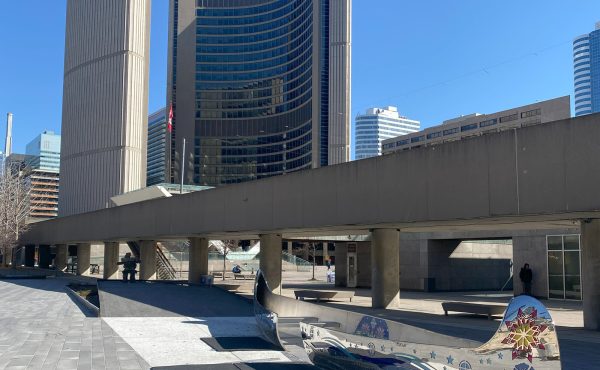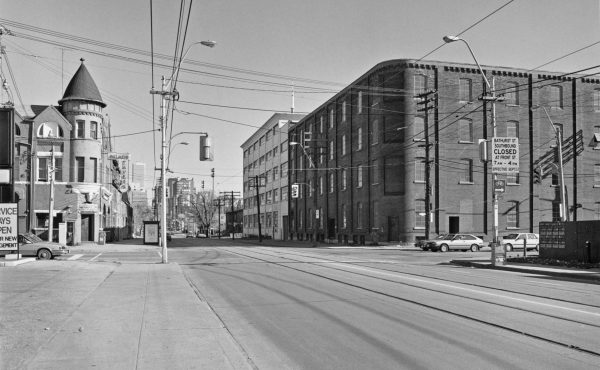When I look at the wonderfully clean map that Uber has provided for its new jitney service, it’s not hard to see how frustrated commuters from transit deserts like Liberty Village might be lulled into believing that the San Francisco sharing monster will solve their morning problems.
After all, the routes look like they could be drone flight paths, all converging on King and Bay.
But as the Uberati will soon discover, those shared cabs must navigate the same core streets that are already so clogged they have slowed transit service to a crawl.
What does Uber know that the TTC doesn’t know?
Nothing, really, except how to use its considerable marketing savvy to capitalize on turning point moments the TTC should ordinarily have to itself, such as the introduction last week of the proof-of-payment rear door access on streetcars (this isn’t the first time Uber has piggy-backed on transit news to market itself).
Indeed, the UberHop service could well contain the seeds of its own demise. Yes, riders will get to sit. But if there’s a surge of consumer/commuter interest, the congestion on downtown streets may actually get worse, prompting those frustrated TTC defectors to ask themselves if paying a $5 fare to get stuck in traffic is any better than paying a $3 fare to get stuck behind traffic on a streetcar. And I guarantee that all of them will be watching the clock.
The city’s response will be more interesting to observe. If the TTC’s senior managers are smart, they will quickly abandon a legal retaliation response and instead deploy some kind of short-haul shuttle service to those neighbourhoods where Uber is doing its fishing.
In fact, there really should be no mystery about how to respond to this specific threat: Uber’s revealed its hand, and the TTC can use the market signal — those maps! — to test drive some not-so-new ideas, e.g., a mini-bus/jitney service that works areas like Liberty Village or the Distillery District. (Vancouver uses mini-buses as well as standard city buses, and the sky didn’t fall.)
But what about the TTC’s political masters? As with the cab industry, Uber poses two forms of competitive threat: one is particular and commercial (loss of business to a rival) and the other is general and reputational (we can do it better, cheaper, cleaner, etc.). In the short term, the TTC can step on the UberHop service, one way or the other. But what it can’t easily do is untangle the massive goodwill deficit that has made UberHop (and Line Six, its short-lived predecessor) possible.
The fault, it bears saying a thousand times, doesn’t lie with the TTC itself. The TTC’s problems are symptomatic of an irrational decision-making process that under-invests in high density areas but shovels vast troves of cash into suburban white elephant schemes that won’t dent congestion anywhere.
What UberHop should do, more than anything else, is force Toronto city council to bear down on this pivotal problem of opportunity cost: by spending money on one thing, we will not spend money on another thing, or, more precisely, a lot of other things.
City council is allocating an insane amount of cash — $3.5 billion in the best possible scenario — on a three-stop subway i Scarborough that may or may not redress some allegedly ancient wrong, but will never produce sufficient ridership to justify the excessive (and possibly unknown) capital and operating costs.
At the same time, we haven’t got a clue about how to provide suitable rapid transit in high-growth areas so starved for service that they’re now being targeted by private companies gambling that the city will cave in the face of competition.
More than anything else, UberHop’s arrival provides crisp third-party validation of a critique about under-investment that Tory, local politicians, and provincial cabinet ministers have been hearing, but not listening to, for many years.
Which is this: not only is the Scarborough subway (and other such purposeless megaprojects) a monumental waste of scarce resources; it is a project that makes a grand mockery of Tory’s anti-congestion rhetoric and positioning.
UberHop will put many more bulky private vehicles on all those downtown streets that the mayor claims to be so concerned about. It will siphon revenue from a transit service he says requires more resources. And its mere existence wonderfully illuminates the sheer foolishness of council’s recent transit investment choices — choices, it must be said, that Tory stubbornly refuses to revisit.
And all for $5 a ride.






4 comments
When a private shuttle from Mimico appeared and failed, TTC came up with the 145.
And although Line 6 failed, TTC a few relevant plans for the area, namely an extended 172 bus running from the Distillery District to downtown along The Esplanade and a new 121 Bremner which will run from Bathurst St and Fort York to downtown.
The TTC is also looking at dropping the double fare for the Downtown Express buses if they can find the money.
If they could get the city to support HOV lanes on some crucial routes (like Lake Shore between Jarvis and York for the benefit of GO buses, and on Richmond, Adelaide, King, Wellington and Front for the benefit of the TTC) there might be something here.
Cheers, Moaz
This assumes Tory and the majority of Councillors want the TTC to succeed. As noted, the reasons for why expansion has not occurred in new downtown communities is political.
Many regard the TTC as a waste of money with high paid workers that should be replaced by profitable private companies using cheap labour. Both the private taxi networks and Uber have also built relationships with officials through lobbying, financial donations and campaign work. Tory’s successful electoral chief of staff was promptly hired by Uber to turn Tory into an uber Uber booster.
Many think downtown has too much transit, and that it should be doled out more equally by residential population and land size, rather than demand. Others view surface transit, particularly streetcars, as a source of congestion, which should be cut back and eventually replaced by off-road options. Some argue that large buses or streetcars are less efficient than fleets of minibuses, vans or cabs. Given that the biggest expense is labour, when occupied, larger vehicles are much cheaper and more space efficient (e.g. central Toronto in rush ‘hour’).
Recently the city resurrected the western waterfront line (Bremner etc..) study, but given the amount of officials who want the TTC to fail, it is hard to say whether embarrassment will force the Mayor and Council to actually fund the eventual recommendations. Too often the lack of funding leads to the bare minimum of infrequent buses used by a tiny amount of people.
Glad your pegging the problem – the suburban domination of our trans*it. The city core gets milked to help prop/subsidize suburban services, and the suburban politicians dominate (and in some cases dumbinate) the core.
I’m sure there was a good solution to the Liberty Village problem a decade ago in doing a Front St. transitway instead of a roadway, but despite the OP, and the nudgings over many years, nope, we couldn’t conceive of a transit solution, and sadly, it was also “progressives” that were lacking vision to a transit option to the Pantalone Parkway, which may still be lurking in doing a small bit of the local road vs. transit. We may still be able to partially do a sped-up transitway by using the north side of the Weston corridor from Queen/Dufferin to Bathurst/Front, but it’s only been a couple of years thus far, and the major mountain is the folly of the Scarborough subway blight, which is a triumph of scheming over planning.
The City is also very content to keep biking dangerous – but we need bikeway relief of our transit on the King/Queen axis as well as the Bloor/Danforth subway. There are no real plans for doing anything about the overcrowding in the near future and in the case of Bloor,/Danforth the absence of streetcar tracks make the possibility of a bikeway relief almost an overnight thing. We’d rather change the climate than parking spaces though, or so it seems, and isn’t it about time for another unanimous motion about climate change dear Clowncil??
The Scarborough subway is a complete waste of money.
The LRT from Kennedy to Scarborough Town Centre ( and McCowan) is certainly used by folks traveling to work, to school and to shopping; but it is fraught with breakdowns, especially in winter.
A proper service to those people who live and work east of Kennedy would be a much better idea.
Just stand at the Kennedy bus platform and watch the crowds waiting for a bus to take them east along Eglinton. The TTC introduced an extended bus route 34…but only during rush hour.
I say extend the Kennedy station east, then split it at McCowan Road to the town centre, and the other branch further east past Morningside to West Hill/Highland Creek.
GO transit does not run all the time like the TTC, so alternates are needed.